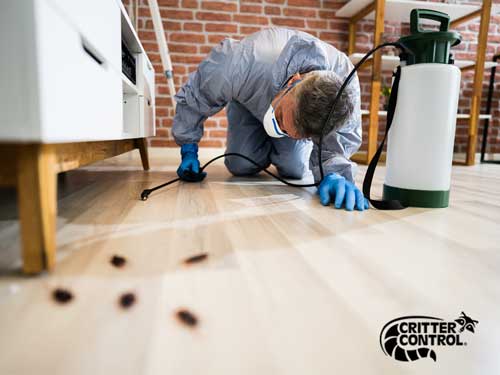Trusted A1 Bed Bug Exterminator Charlotte - Do Away With Bed Bugs Quick
Trusted A1 Bed Bug Exterminator Charlotte - Do Away With Bed Bugs Quick
Blog Article
Bed Insect Therapy Break Down: Contrasting Chemical Vs. Non-Chemical Solutions
In the world of pest control, particularly when managing the consistent problem of bed insects, the choice in between chemical and non-chemical treatment options can be a critical one. Both approaches provide distinctive advantages and drawbacks, influencing factors such as efficiency, safety and security factors to consider, and general cost. By checking out the nuanced information of each approach, a more clear understanding of which path to pursue in attending to a bed insect infestation can be acquired.
Efficiency of Chemical Therapies
Chemical therapies for bed insect invasions have actually been widely acknowledged for their potent and quick efficacy in eliminating these parasites. When thinking about the efficiency of chemical therapies, it is important to recognize that they can provide a quick and complete remedy to a bed bug problem.
Furthermore, chemical treatments have the advantage of offering residual results, meaning that they can continue to eliminate bed pests even after the preliminary application. This residual action is specifically helpful in combating any possible re-infestations. Furthermore, the quick activity of chemical treatments can bring alleviation to people encountering extreme bed insect invasions, allowing them to reclaim control of their home swiftly.
Safety Interest In Chemical Solutions
When making use of chemical solutions for bed pest therapy is guaranteeing the safety of owners and the setting,One critical element that requires mindful factor to consider. While chemical treatments can be effective in eradicating bed bugs, they may posture dangers if not dealt with correctly. One of the key security issues with chemical remedies is the potential damage they can create to human wellness. Exposure to certain chemicals utilized in bed bug therapies can cause breathing issues, skin irritation, or other damaging responses, particularly in people with pre-existing problems or sensitivities. Additionally, incorrect application or dosage of chemical pesticides can lead to hazardous deposits remaining in the treated location, presenting long-term health and wellness threats to owners.
Additionally, the ecological impact of chemical solutions is an additional substantial consideration. Some pesticides used in bed insect treatments might be harmful to useful pests, wild animals, and environments if they leach into the dirt or water supply. It is important to use chemical treatments judiciously, following safety and security guidelines, and taking into consideration much less toxic choices to mitigate these dangers and ensure the safe and reliable management of bed bug infestations.
Advantages of Non-Chemical Techniques
Thinking about the prospective safety and security problems and environmental effect associated with chemical services for bed insect treatment, discovering non-chemical methods offers a promising option with numerous distinct advantages. Non-chemical therapies are ecologically pleasant, as they do not add to air or water air pollution, making them a lasting selection for insect control.
Furthermore, non-chemical options can be efficient in targeting bed insects, including hard-to-reach locations where chemical treatments may not permeate. Methods such as warm treatment, vacuuming, vapor cleaning, and cushion encasements give extensive eradication without making use of dangerous chemicals. In addition, non-chemical approaches can be much less disruptive, calling for marginal prep work and permitting quicker reentry into treated areas. Generally, selecting non-chemical bed bug treatment techniques not only focuses on security and environmental management however also guarantees thorough and reliable parasite control.
Limitations of Non-Chemical Treatments

In addition, non-chemical therapies typically require multiple applications to attain successful eradication. This can be taxing and might not always ensure full elimination of all bed bugs and their eggs, specifically in hard-to-reach or covert places.
Additionally, the success of non-chemical therapies greatly relies on appropriate application and thoroughness, which can be challenging for individuals without professional proficiency. Poor application of non-chemical techniques may lead to insufficient elimination, resulting in relentless infestations and the requirement for added treatments.
Therefore, while non-chemical treatments have their benefits, it is important to acknowledge these restrictions and consider them when determining the most reliable strategy for taking care of bed pest problems.
Cost Comparison: Chemical Vs. Non-Chemical Options
Provided the constraints connected with non-chemical A1 exterminators charlotte nc therapies, a vital aspect to evaluate in the context of bed pest monitoring is the cost contrast in between chemical and non-chemical choices. In contrast, non-chemical therapies like warm treatment or heavy steam can be a lot more pricey, with costs varying from $1,000 to $6,000 for an entire home. While the preliminary expense of chemical therapies might seem reduced, several therapies may be needed to totally eradicate the invasion, possibly enhancing the total price.
Verdict

Thinking about the potential safety issues and ecological impact associated with chemical remedies for bed pest therapy, checking out non-chemical techniques presents an appealing alternative with numerous distinct advantages.Given the constraints associated with non-chemical treatments, a necessary element to evaluate in the context of bed pest administration is the cost contrast in between chemical and non-chemical choices. In comparison, non-chemical therapies like warmth therapy or steam can be extra costly, with costs ranging from $1,000 to $6,000 for an entire home. While the preliminary cost of chemical therapies might appear lower, numerous therapies may be needed to fully get rid of the infestation, possibly increasing the total price.In conclusion, when contrasting chemical and non-chemical bed pest therapy alternatives, it is essential to take into consideration effectiveness, safety and security, advantages, restrictions, and cost.
Report this page